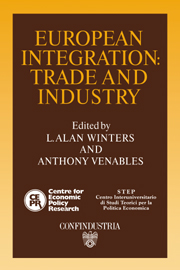Book contents
- Frontmatter
- Contents
- List of figures
- List of tables
- Preface
- Acknowledgements
- List of conference participants
- 1 European integration: trade and industry
- 2 Completing the internal market in the EC: factor demands and comparative advantage
- Discussion
- 3 External effects and Europe's integration
- Discussion
- 4 The quality and production of textiles and clothing and the completion of the internal market
- Discussion
- 5 Competition and imports in the European market
- Discussion
- 6 The structure and determinants of East–West trade: a preliminary analysis of the manufacturing sector
- Discussion
- 7 1992 and EFTA
- Discussion
- 8 Technology policy in the completed European market
- Discussion
- 9 Corporation tax, foreign direct investment and the single market
- Discussion
- 10 Japanese direct manufacturing investment in Europe
- Discussion
- Index
Discussion
Published online by Cambridge University Press: 07 September 2010
- Frontmatter
- Contents
- List of figures
- List of tables
- Preface
- Acknowledgements
- List of conference participants
- 1 European integration: trade and industry
- 2 Completing the internal market in the EC: factor demands and comparative advantage
- Discussion
- 3 External effects and Europe's integration
- Discussion
- 4 The quality and production of textiles and clothing and the completion of the internal market
- Discussion
- 5 Competition and imports in the European market
- Discussion
- 6 The structure and determinants of East–West trade: a preliminary analysis of the manufacturing sector
- Discussion
- 7 1992 and EFTA
- Discussion
- 8 Technology policy in the completed European market
- Discussion
- 9 Corporation tax, foreign direct investment and the single market
- Discussion
- 10 Japanese direct manufacturing investment in Europe
- Discussion
- Index
Summary
This study makes a valuable and timely effort to analyse patterns of trade between countries expected to integrate rapidly during the 1990s. I fully share the authors' (hereafter NR) expectation of net gains from trade from East–West integration, owing to fuller exploitation of comparative advantages and economies of scale, leading to greater inter-industry as well as intra-industry specialisation.
I do, however, not really share NR's trust in the analytical and econometric apparatus funding their conclusions. Inferences about gains-losses from integration drawn from ‘revealed factor abundance’ (see also Neven, 1990) seem to me rather weak. While I agree that trade data must be a fair guide to the actual comparative advantage even in a state trading setting (section 3), I stay rather sceptical about neoclassical factor intensities according to standard measures being meaningful and reliable sources, or even determinants, of actual absolute and comparative advantages. We should not forget that the factor abundance–intensity apparatus, even in its weaker form, implies the notion of pure elastic demand for factors as homogeneous inputs substitutable on the basis of freely available technologies. True, in their econometric tests of patterns of trade between the EC and COMECON NR go well beyond the standard Heckscher–Ohlin scheme, taking a standard multivariate approach dating from Baldwin (1971) and Hufbauer (1970), and widely employed thereafter. However a multivariate eclectic approach raises a number of theoretical and methodological issues, so that traditional gains from trade can hardly be inferred and factoral and neofactoral abundance becomes blurred.
- Type
- Chapter
- Information
- European IntegrationTrade and Industry, pp. 115 - 119Publisher: Cambridge University PressPrint publication year: 1991



